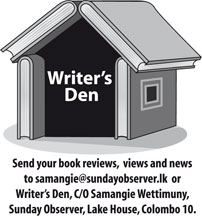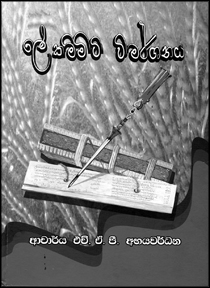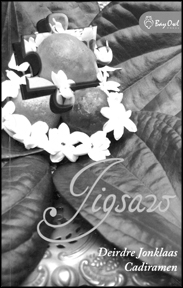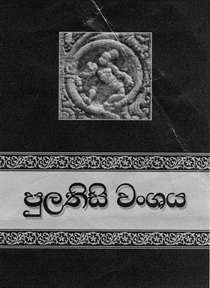|

A research work born out of much dedication
Reviewed by Padma EDIRISINGHE
The expanded title of this rather massive academic compilation is "A
critical examination of Secretarial Records of the Kandyan
administration" which does it more justice and even specifies the
content. It is an outcome of a four year research by one of our foremost
academia who has put out a wide range of books after meticulous
research. Perhaps this can be dubbed as his crowning work since a
research on Lekam miti which was as important as Kada Im Poth had not
been hitherto attempted for a scientific study.
 His texts in English and Sinhala on Kada Im Poth (Boundaries of
Lanka) are well-known. Keeping secretarial records in streamlined order
is a very necessary requirement for good governance. To many of those
who subscribe to the view that all advanced aspects of civilization
seeped into the East from the West and hence are naturally subject to
the delusion that the streamlined collection of data regarding people
and property and territorial divisions and such like, all matter basic
to good administration, too began after the advent of the Whites, this
book would no doubt come as a surprise. Such records had been maintained
by our administrative hierarchy on a regular basis even in times of
acute warfare and internal dissension. His texts in English and Sinhala on Kada Im Poth (Boundaries of
Lanka) are well-known. Keeping secretarial records in streamlined order
is a very necessary requirement for good governance. To many of those
who subscribe to the view that all advanced aspects of civilization
seeped into the East from the West and hence are naturally subject to
the delusion that the streamlined collection of data regarding people
and property and territorial divisions and such like, all matter basic
to good administration, too began after the advent of the Whites, this
book would no doubt come as a surprise. Such records had been maintained
by our administrative hierarchy on a regular basis even in times of
acute warfare and internal dissension.
In fact Maha Lekam of the Kandyan administration who was responsible
for the compilation, revision and updating of these documents, according
to the book, has been the second highest officer in the official rungs
earning pride of place in the ceremonies even of The Mahanuwara Esala
pageant.
Of the four types of Lekam identified in this study the Maha Lekam
was directly responsible to the king in the compilation of Kathal and Hi
Lekam miti used for revenue administration. Other Lekam miti such as
Dunukara Lekam miti, Disa Lekam miti and Maha Lekam miti were compiled
to meet the needs in the administration and were kept with the
respective territorial divisions under the four Maha Disawas eight
Disawas and nine Ratemahattayas.
All this information is presented in 18 chapters. The two appendixes
are equally valuable, the first containing the actual text of Lekam miti,
indeed a copious task. Reading through the pages it is clear that the
book has not been a mere desk - work produced in the comfort of an AC
room in an affluent part of Colombo. The author had traversed the length
and breadth of the Kandyan terrain, visiting temples up on rugged
mountains or down in deep valleys and interviewing colleagues like late
Kapila Vimaladharma and accumulating information to fill in gaps.
Despite age, he has played the role of the true and genuine researcher
digging much valuable data that otherwise would have been long buried in
the silence of cemeteries.
In that respect the nation really is in debt to the author, who also
has made generous use of the Archives, Colombo Museum library and Royal
Asiatic Society library.
The book is profusely replete with maps, flags of divisions and line
drawings augmenting the research visually. The many top State posts the
author has held and the multitude of academic assignments no doubt
facilitated the accumulation of the required content over the years.
Appendix Part II comprises a set of historical documents which though
not immediately connected to the topic are vibrant pieces of
information. Some of them are the Kandavuru Siritha that gives the daily
ritual of a king of bygone times i.e. Panditha Parakramabahu, the
Sannasa bestowed by King Kirthi Sri Rajasinghe on Palingupana Rajaruna
Rajapakse of Matara, the 1766 Treaty between the Dutch and King Kirthi
Sri Rajasinghe, a sample of Portuguese Thombu and Dutch Thombu and the
First Census Ordinance and the list of officers in the Kandyan kingdom
as listed by John Doyly. The Matara Sannasa reveals the dichotomy of
position held by Matara, both as a vassal state of Kandyan Kings and
that of Westerners.
Re-produced verbatim after hunting them down, these documents further
give interesting peeps into the nature of the Sinhala language used in
contemporary times. The Lekam miti, it is almost superflous to state are
significant in the field of nomenclature too since they disclose the
personal names used in the Kandyan period. Some of the families
included, the reviewer, notes go on to modern times. After all it is a
matter of 3 to 4 centuries in the incredibly long voyage of Time. An
interesting observation is that many areas now bracketed into the
Western province were attached to Hatara Korale and no doubt belonged to
King's Land during Portuguese and Dutch times. Such is the passage of
history which is a non-articulated message this compilation delivers.
The book too focuses on the pooja paid to writers in Sri Lanka from
ancient times, be they writers of Lekam miti or general writers. Right
from the beginning this tradition had persisted. As early as 3rd Century
BC King Devanam Piya Tissa had conferred the title of Lakdiva Jaya Maha
Lenawo (the celebrated chief Lekam of Lanka) to Prince Bodhigupta who
had come over here in the retinue carrying the Bo sapling. This post of
Jaya Maha Lenawo had retained its predominance right along. The author
has taken pains to sieve out details regarding the recognition of
writers throughout the ancient and medieval periods of Sri Lanka listing
also the categories of Lekam. Extensive quotes have been used from the
works of Ralph Peiris and John Doyly and many other sources to
substantiate facts.
It is once again reiterated that on the whole the book is a rare
research work born out of much dedication and labour filling a much
needed void in academic compilation in this field.
Jigsaw :
A bit out of life
Reviewed by Ranga CHANDRARATHNE
Extremely unassuming in tone, Deirdre Jonklaas Cadiramen paints a
portrait of Sri Lankan life in her latest anthology of short stories
'Jigsaw'. Her stories are peopled with characters from diverse strata of
society intermingled with vivid memories and life experience that she
underwent at the early part of the 21st century. The stories are as
vivid as their subject matter. The themes are often drawn from her own
milieu. Yet they are candid and simple in diction bereft of Ceylonism.
The book is marked for its insightful recreations of incidents of the
past particularly referring to the communal riots, archetype attitudes
of villagers on women and the authentic depiction of village life.
The very first short story of the anthology, 'The bride wore black',
though was about a commonplace experiences, the story has been depicted
with sensitivity and discipline which is a rarity among contemporary Sri
Lankan writers in English.
 'Ruth was an only child. Lonely, she overcame solitude, daydreaming
of siblings and good times they'd share. Transparent were her white
lies, ending unfinished games with children of the neighbourhood in
unvarying pretext. She would look at her watch, re-tie her shoelaces,
arrange her plaits on either side of her face, shake creases from her
skirt, and announce: "Got to go feed my baby brother, and check my
little sister's. 'Ruth was an only child. Lonely, she overcame solitude, daydreaming
of siblings and good times they'd share. Transparent were her white
lies, ending unfinished games with children of the neighbourhood in
unvarying pretext. She would look at her watch, re-tie her shoelaces,
arrange her plaits on either side of her face, shake creases from her
skirt, and announce: "Got to go feed my baby brother, and check my
little sister's.
The start of the story is, perhaps, most effective and suited to the
plot of the story and the ending is dramatic. One of the significant
aspects of writing is that the sharp eye for details yet told in
unambiguous terms, sparingly using metaphors and idioms. However, there
are expressions such as 'Ruth was an only child' instead of Ruth was the
only child which betrays the influence of language other than English on
the writer. Most of the stories in the anthology are narrated from a
third person narrative style or from the perspective of an unseen
person. It should be stated here that this technique which the author
employs, has been successful on most of the occasions. In 'The bride
wore black', the story is told by daydreaming Ruth which gives a sense
whether the account of Aunt Cornelia's wedding is part of Ruth's
dreaming or something which Ruth dreamed and happened in reality.
'Attitude' is, perhaps, one of the most effective short stories which
highlights on some of the erroneous prototype attitudes and perceptions
on a section of the population through incident of child loss in a
supermarket. Although the incident is simple, the author has effectively
brought out attitudes of diverse personalities representing gamut of
socio- cultural traits.
'An angry woman came running as if from nowhere. Put her down this
instance, before I call the cops... Sorry I mistook.. I know your type.
Weirdo! Stealing other people's children. Although it is a mistake, the
child's mother, refuses to believe grieving mother of the child who is
lost among the crowd.
'It began all with the birds' is a story which deals with belated
diagnoses of an strange disease which causes an untimely death. This is
one of the instances where the author has effectively used third person
narrative. The prolonged illness of Carol, who is the lead character of
the story and is an ardent bird lover, has been depicted in realistic
manner.
'A Quirk of Fate' is a story of an entrepreneur woman whose life was
completely changed following an accident. What is important in the story
is not the plot but the way the author arrives at it; the author has in
fact, described not only the idyllic beauty in the village of
Deiyyandara but also common traits that the village community shares
with the rest of the country.
Within such close-knit community, relationships fostered, each
referring to other as aachchi or seeya, nanda or maama, akka or nangi,
aiyya or malli; reserving amma and thaatha for their biological parents.
Involvement in one another's affairs was accepted. In this
unsophisticated setting of home-births, funerals in family
burial-grounds, unrecorded births and deaths, romantic liaisons replaced
matrimony. Infidelity was alien; caste consciousness zero- percent.
Administrators representing authorities arrived infrequently and
unannounced; to regularise de facto relationships by mass marriages,
register births and deaths, conduct census; compile statistics.
Inhabitants of Deiyyandara were no different in attitude to the rest of
Sri Lanka, believing women lived in the shadow of men, confined to home,
childbearing, child-rearing, tending aged relatives, bullied by in-laws.
Having the world's first democratically elected woman Prime Minister
altered this notion somewhat.
Here the author insightfully, portrays the cultural landscape,
perceptions and attitudes in general on the part of the community and on
women in particular. Women's role, albeit changed according to class and
social status, has, by and large, confined to childbearing, childrearing
and being in the shadow of men.
'Black Friday' is a story about an incident occurred during the riots
in Colombo. Here the author has successful in vividly realising the mob
violence of the day which resulted in the death innocents at the hands
of the lunatics.
Although the author was able to recreate the atmosphere of the day,
the last couple of sentences sound statements rather than part of the
story. However, what the author expressed at the end of story has
already been eloquently expressed in the story albeit through an
incident.
The stories such as 'Wedding Gust', It happened in the Swinging 60's,
'Opportunity only knocks Once', 'A Friend in need', 'The gift',
'Signed', 'Sealed and Delivered', 'The visit' and 'Friendship, Flowers
and a Funeral' explore diverse aspects of life. The author has gone
beyond storytelling and is marked for her sharp insights into life of
different segments of population. At times, the author's thorough grasp
of rural reality in Sri Lanka is amazing.
In terms of language and use of metaphor, the author has cut an edge
over the other writers in English. Her language is matter-of-fact with
sparingly laced out metaphors and idioms from Sinhala. The book is
published by Bay Owl publishers and is dedicated to the memory of TOFFEE
(Female Lhasa Apso).
Opening new vistas for future scholars
Reviewed by C. A. Lenin DIVAKARA
Jananathapuram was the ancient name of present day Polonnaruwa as
mentioned in chronicles and inscriptions. King Wijyabahu who defeated
the Chola invaders was able to bring the whole island under one rule,
similar to modern day unitary states. The Polonnaruwa era which lasted
nearly two centuries, declined due to alien invasions but the marvels of
economic development mainly engineering feats like giant reservoirs
continue to irrigate the land of Rajarata and aesthetic masterpieces
like sculptures at Galviharaya and Dagabos still foster spiritual values
in the minds of people. But later, the jungle tide swallowed up the
ancient kingdom (so colourfully described by John Still) depriving the
nation of its material and spiritual wealth.
 |
|
“Pulathisi Wamsaya”
by Nihal P. Jayatunga |
Polonnaruwa succeeds Anuradhapura as the capital of Sri Lanka in the
11th century and continued to be so for nearly two centuries. Under the
reign of Kings Parakramabahu I, and Wijayabahu, Polonnaruwa Kingdom was
noted for glorious achievements in the economy and culture, the economy
having been stabilized with marvellous seats of engineering in the
sphere of irrigation. Cultural development was prominent in the fields
of arts, crafts and literature. The Sinhala literature attained
tremendous heights and the art of sculpture developed as a fine art,
ancient Sinhala sculpture having created masterpieces, most famous being
the images of the Most Enlightened One and his disciples masterfully
carved in stone.
The sculptor's genius in capturing the serenity of the great Teacher
speaks volumes of their spiritual heights that blended with their superb
craftsmanship parallel to the refined artistry of sculpture and
paintings. The era of Polonnaruwa marked a turning point in the history
of Sri Lanka, for the first time, the impact of Indian culture was
deeply felt. It is debatable whether such impact led to an enrichment, a
positive contribution to the indigenous culture.
The Sinhala chronicles which are considered unique in the world
literature were written by erudite monk scholars whose unrivalled
mastery of Sinhala. Pali, Sanskrit and Tamil helped them to delve deep
into the past and compile information related to race, religion and
statecraft. The monk scholars had their favourite monarchs and of course
whom they detested. So, most chronicles are biased and mirrored the
authors' prejudices. Nevertheless, these chronicles contained valuable
information. Historians strongly recommend them as valuable sources. It
is left to the discriminating reader to analyse them.
No chronicle has ever been written containing detailed information on
history, geography and culture of the era of Polonnaruwa.
Thanks to the compilation of the "Pulathisi Wamsaya" the long felt
need has been fulfilled. The untiring efforts of the editor, Nihal P.
Jayathunga, the Media Consultant to the Ministry of Cultural Affairs and
National Heritage who undertook the task of compiling "Pulathisi Wamsaya"
deserves public commendation.
Incidentally, the publication of "Pulathisi Wamsaya" was apparently
the only project of the National Literary Arts Festival that won acclaim
of the public and critics.
Significant role
Looking back at the history of Sinhala literature, chronicles played
a significant role in disseminating information on political events,
social system and cultural development of a historical period related to
a Kingdom. As such, Poojawaliya, Daladasiritha, Thupawamsaya, Chula
Wamsaya, Bodhi Wamsaya, and Attanagalu Wamsaya were written by erudite
monk scholars of repute depicting the significance of the events in the
political and social context. The most famous of the chronicles is "Maha
Wamsaya" which is the most comprehensive source of the history of Sri
Lanka.
These valuable contributions to the history of a nation and a country
are rare in the world literature and are infact creditable achievements.
They are an ample testimony to the erudition and dedication of the
authors of yore.
Besides, the value of Sinhala chronicles as historical sources, they
are unique as literary masterpieces as well. The sensitivity, sincerity
and the artistry of the author are depicted in the chronicles. Moreover,
the inner world of the personality of the author too is depicted in
these chronicles. In contrast the modern chronicle, "Pulathisi Wamsaya"
is a joint effort of a group of eminent scholars, specialized in each
field of human activity and aspect of history. Unlike the ancient
Sinhala chronicles, "Pulathisi Wamsaya" has the stamp of authority in
that the contributors have earned recognition in their respective
fields, sociology, archaeology, arts and crafts, literature, geography,
folklore and sculpture. So the literary or artistic style of an
individual author is not present in the modern chronicle but to
compensate amply, the eager reader would have the opportunity to form
his opinion on Polonnaruwa, its heyday, its decline and its contemporary
state through well-balanced, scientific, authoritative, analytical,
highly descriptive articles contained in "Pulathisi Wamsaya". In this
sense, "Pulathisi Masaya", rivals only "Matara Wamsaya", also a
publication of the Ministry of Cultural Affairs and National Heritage,
compiled by the same editor and published to mark the National Literary
Arts Festival held in Matara last year. The flag of Thamankaduwa
Disawani with the unusual design adorns the volume, meaningfully
depicting the historic significance of the era of Polonnaruwa. The
messages of the President, Prime Minister, the Minister of Cultural
Affairs and National Heritage and the Minister of Agricultural Services
and the Minister of Agricultural Development and Agrarian Services and
the Secretary to the Ministry of Cultural Affairs and National Heritage
and the preface by the editor are immensely readable and informative and
enlightening too. A glance at the contents reveals the wide variety of
areas covered by articles contributed by the experts in the respective
fields. The galaxy of academics who contributed articles shed ample
light on the unexplored areas of the history of Polonnaruwa through
their research.
Illustrations, photographs, charts, tables and diagrams elucidate the
information and the comprehensive bibliography and footnotes help the
reader to seek valuable sources to gather knowledge.
Besides the value as a source of information on the history and the
literature of the Polonnaruwa era, several articles in the volume
provide information on the natural wealth of the district, its wild life
forests, national parks, eco system, bio-diversity etc.
New dimension
Pulathisi Wamsaya adds a new dimension to the art of compiling
chronicles in that it covers the ancient medieval, colonial and
post-colonial periods and also the geography in its all aspects. The
chapters on the colonial and the post-colonial periods are enriched with
information on colonization of the Polonnaruwa district which brought
about catalystic economic social and cultural changes. The articles on
the history in the "Pulathisi Wamsaya' analyse the achievements of the
monarchs, Wijayabahu and Parakramabahu and assess their achievement
without bias. They also analyse the causes for the decline of the
Polonnaruwa Kingdom and the impact of the Indian invasion.
The contribution of the monarchs to the development of agriculture
through the construction of giant irrigation works are highlighted. It
is historically significant that even during the Anuradhapura era,
Polonnaruwa had played a vital role in agriculture which indirectly
strengthened the Anuradhapura kingdom by sustaining it with essential
food supplies. However, the decline of the Anuradhapura kingdom paved
the way for the emergence of the kingdom in neighbouring Polonnaruwa.
The compilation of the chronicles like Matara Wamsaya and Pulathisi
Wamsaya is assessed as a part of the Sri Lankan cultural heritage. They
will enlighten the common man's vision of the past which in turn will
help him to understand the complexities of the present and equip him to
face the challenges of the future. In this sense, Pulathisi Wamsaya and
Matara Wamsaya are invaluable guides specially to the younger
generation, the majority of whom, I believe, are not adequately
knowledgeable in history. An understanding of world history and of one's
motherland is a vital factor that broadens one's world outlook and
deepens understanding of the humanity, in general and nation in
particular. In this context the enrichment of cultural life of
individuals in a community, in turn reinforces its sense of identity,
that is, national identity which goes a long way in the task of
nation-building. Because of this value of the publications of this
nature, as promoters of national identity I strongly recommend that they
should be introduced to libraries in every school. May I suggest that
the educationists and educational authorities should take meaningful
steps to make use of the new chronicles as a supplementary reading for
students and instruct teachers to use them in instilling a sense of it
in the pupils so that they may contribute to national resurgence as
patriotic citizens with positive approach to life.
Pulathisi Wamsaya possesses an added value with several articles
based on academic research and archaeological information gathered from
recent excavations made in places such as Thopawewa Irrigation System.
Nagalakanda, Buduruwayaya, Dimbulagala and Somawathie Chethiya which had
revealed a period that had existed before the Polonnaruwa era. However,
scholars may wonder why Thopawewa and Buduruwayaya have been given more
prominence than the Galviharaya and Rankoth Viharaya.
I believe that the objective of the editor may be to make the reader
aware of startling revelations made in recent excavations and the latest
research should be made available for scholars to pursue their studies
and arouse the interest of the present and future generations. In fact,
the main objective of the compilation of the Pulathisi Wamsaya is to
open new vistas for future scholars. However, every effort has been made
to present Pulathisi Wamsaya in a lucid style to sustain the interest of
the lay reader.
"Pulathisi Wamsaya" is a step forward towards the realization of the
concepts related to national heritage as provided in for `Mahinda
Chintanaya'. As such the author Nihal P. Jayatunga deserves commendation
for his excellent work. |

